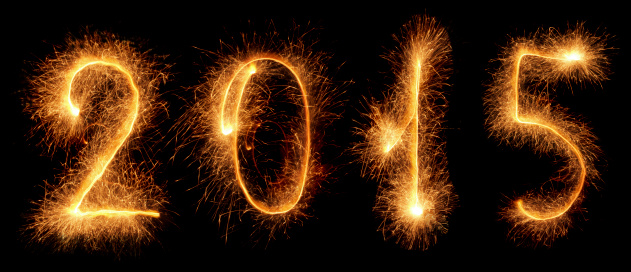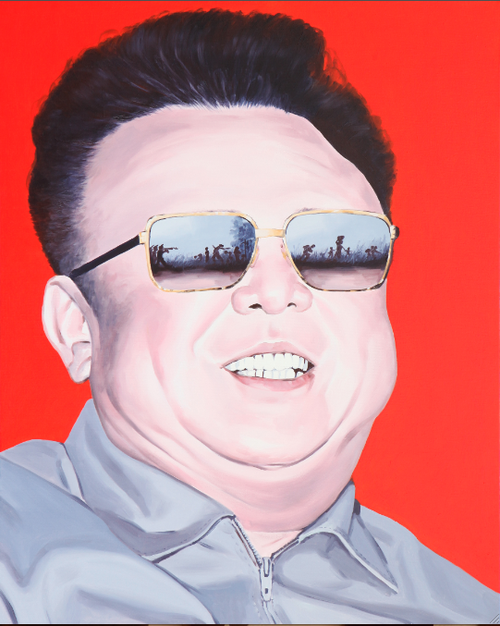Thursday 31st December 2015Farewell 2015!

Farewell, good 2015! It's been a glorious year, and a perilous year, a creative one and a frustrating one. Like all good years, it was full of all the intricately woven threads of life. On this New Year's Eve, take the chance to look back over the past year and think about how it's changed you, and how you changed the world around. Not the world at large, for few of us are lucky enough to manage that with our art, but we can always change our own smaller worlds; the world of our friends, families and fans, or even just our own personal views of the world.
As you look back, remember Janus, the god with two faces, who looks backwards and forwards at the same time, and rather than focusing too deeply on the split between years, consider it as a signpost in a constant flow of the creative experience we call life. What you've created in the past will inform and shape what you create in the future, because even if you decide to take your artistic career in a completely new direction this year, that choice is still informed by everything that you've done and everything that has happened to you up until this point.
We've also got a fun little project that you might want to consider trying over the course of 2016, in preparation for next New Year's Eve (or sometime around then, it's your call, of course). Take a glass jar, perhaps a pickle jar size, and grab a stack of post-it notes or something similar. Over the course of 2016, every time you have a creative idea, whether you act on it or not, write down a quick note with the date and pop it into the jar. On New Year's Eve 2016, the eve of 2017, open up the jar and take a look back at all the ideas and watch them unfold in chronological order. Not only will you get a better sense of how your ideas progress over the course of the year, you'll probably find some great ideas that you forgot about that you can keep in your back pocket for the next time you find yourself in a bit of a creative slump.
No matter how you choose to celebrate, here's hoping that you have an excellent, creative, inspiring and beautiful 2016!
Posted on December 31st 2015 on 02:42pm
0 Comments
Tuesday 29th December 2015Artist Spotlight: Shia LaBeouf

Hopefully you won't feel we're focusing a bit too heavily on Shia LaBeouf, who has been the subject of a number of postings this year. Surprisingly enough to some, however, the actor really does seem to be making a go of his performance art pieces, and people are finally starting to take notice beyond merely scoffing at his pieces.
In case you missed them, there have been a number of pieces over the last year or two, starting with the bizarre incident where he wore a paper bag with two eyeholes over his head bearing the words "I'm not famous anymore" to a red carpet event in Hollywood, and progressing from there to a number of subsequent performance art pieces. #IAMSORRY was next, an attempt to apologize for accusations of plagiarism on a previous short film he'd collaborated on where he claims that he "got lost in the creative process and neglected to follow proper accreditation." Essentially, he sat in a room without speaking and allowed visitors in to see him, talk to him, and actually do whatever they wanted to him. Unfortunately, some nasty allegations emerged from it after he claimed that he was raped by a visitor, which is obviously well beyond the bounds of what you could reasonably expect from a performance art piece.
This got even more muddled when art worlders began to notice the striking similarities to the performance pieces of Marina Abramovic, entitled 'The Artist is Present'. This would mean that his apology for plagiarism was actually arguably plagiarism in and of itself, and we begin to spiral down the rabbit hole.
He's since moved on to a couple of other performance art pieces, namely #ALLMYMOVIES, as we discussed in our previous postings, and since then he's also participated in another one where he takes public calls from random members of the public, wrapped in the hashtag #TOUCHMYSOUL. The goal is for people to give him a message that touches his soul, but no word yet on whether or not this is working for him at all.
Perhaps the real question of whether or not you like his performance pieces comes down to your general attitude about celebrity. When we first began covering his pieces, we were completely unmoved, and saw only the mockery of the art world who dismissed him more or less as a matter of course. But there is celebrity in the art world as well, and perhaps those figures could use a little lampooning, a bit of reflection from those who are not part of the accepted canon. Perhaps that will touch their souls.
Posted on December 29th 2015 on 02:40pm
0 Comments
Saturday 26th December 2015Shia LaBeouf Really Wants to be an Artist

Shia LaBeouf has a very complicated relationship with the art world. The actor, probably best known for his roles in the Transformers series and the latest (and arguably worst) iteration of the Indiana Jones series, has been struggling with what he regards as his fall from grace, although there may be some debate among film critics as to whether or not this term really applies. He's been running a series of performance art pieces ever since then, with a wildly varying degree of success in the public and critical perception.
His latest project is apparently a performance art piece, although the performances in question aren't exactly new ones. Instead, LaBeouf spent three solid days in a movie theatre, watching all of the movies he's ever performed in in a giant marathon session. Anyone was welcome to join him for free in the theatre for the entire performance of his collected works, which total a rather surprising 58 straight hours of film. Yes, there were no breaks whatsoever. To cap it all off, the entire thing was livestreamed - but not the movies, rather the stream was focused on LaBeouf himself, so the entire world could watch his reactions (as you can see from the photo we used here, courtesy of NewHive). The entire thing was wrapped under the Twitter hashtag #ALLMYMOVIES, reminiscent of his #IAMSORRY project from earlier this year.
So the real question, of course, is whether or not this is really art. It could be, depending on how you feel about his movies and his general Hollywood presence as a celebrity, or it could be regarded as a juvenile attempt to stay relevant in an industry where he is being taken less and less seriously as an actor. We actually can't decide how we feel about it, to be completely honest. It sort of conjures up memories of Joaquin Phoenix's bizarre concept work for the Casey Affleck film 'I'm Still Here', which chronicled Phoenix's supposed (yet faked) retirement from acting to take up a rap career. But until someone jumps out of the woodwork to shout BOO, we're not entirely sure which way the whole Shia situation could go.
Regardless, we're going to give him what he wants in our next post, as we take a slightly more lighthearted tone than usual in our last Artist Spotlight of the year, in which we'll be examining the merits and pitfalls of the artistic career of Shia LaBeouf.
Posted on December 26th 2015 on 02:38pm
0 Comments
Wednesday 23rd December 2015The Year in Review

What a year! 2015 has had some incredible ups and downs, and hopefully has been kind to all of you loyal readers, both in the creative sphere and in the rest of your life - although they're really all the same thing! We thought we'd take this opportunity to look back at some of our favourite posts from the previous year, in case you missed them.
It was a banner year for inspirational posts from us here at Gallereo, as we covered a number of fantastic idea spinners that hopefully helped to keep you out of the creative doldrums. Whether it was a
new year's blessing, a
Spring cleaning extravaganza, or
creating for your health, perhaps Wayne Dyer said it best: "Everything that's created comes out of silence. Your thoughts emerge from the nothingness of silence. Your words come out of this void. Your very essence emerged from emptiness. All creativity requires some stillness." A bit of a pause at the end of the year to look back and reflect can make all the difference in the world, allowing you to put the past behind you and look forward to all the creativity those experiences will help generate.
We also discovered a number of fantastic artists thought our Artist Spotlight that might help inspire you to new heights. From the fantastically ambitious and surreal Alejandro Jodorowsky to the ever controversial Richard Prince, and from scent artist Anicka Yi to the stunning Earth art landscape abstracts of astronaut Scott Kelly, you can see the entire selection by choosing the 'Artist Spotlight' tag in the column on the right. While they may not all be to everyone's taste, they come from a wide enough range of different styles, media and approaches that there's sure to be something that will tickle your fancy in there.
Please, take a moment to look back through all of what we've covered, and hopefully anything you missed the first time around will catch your attention this time. And now, we'll leave you with the words of Johan Lehrer: "Creativity is a spark. It can be excruciating when we're rubbing two rocks together and getting nothing. And it can be intensely satisfying when the flame catches and a new idea sweeps around the world." May your 2016 be full of creative sparks and artistic passions!
Posted on December 23rd 2015 on 05:48am
0 Comments
Friday 18th December 2015Artist Spotlight: Sun Mu

Typically when we profile an artist for our ongoing Artist Spotlight series, we choose an artist who is educated in a classical style, a product of some type of formalized art education. The artist we're going to be looking at today was certainly trained in a formalized style, but one that we've never approached before.
Sun Mu is a North Korean defector who was originally trained by the oppressive dictatorial regime of the so-called Democratic People's Republic of Korea or DPRK, known to the rest of us as North Korea. Having spent the majority of his career painting large-scale propaganda pieces for the North Korean government, he was lucky enough to escape the country in 1998, leaving behind famine and censorship for a kinder world, but he hasn't forgotten what life was like in the country. He now uses his state-trained skills at propaganda to poke fun at the very leaders he was originally commissioned to glorify.
Once he was settled safely in South Korea, Sun Mu attended Hongik University in Seoul, one of the leading art programs in the country, and his style gradually evolved into a pastiche of his old and new lives. Perhaps this is why he uses the pseudonym Sun Mu, which means "no borders".
Sun Mu is also the subject of a documentary by Adam Sjoberg titled "I Am Sun Mu", which chronicles the artist's life and his first attempted show at a gallery in China. We say 'attempted show' because the show was eventually shut down by the authorities days before the opening due to fears that it would offend the North Korean government. South Korea, unfortunately, also has something of a tenuous relationship with former North Korean artists, as they generally choose to step rather carefully around the North in general. Why he would have chosen to exhibit in China is something of a mystery, but regardless, his works have successfully reached the rest of the world to general acclaim, including shows in the United States, Norway, and Germany.
Koen De Ceuster, a North Korean art expert from Leiden University remarked on Sun Mu's style in the LA Times. "By using the same visual language but … inverting its message, he fundamentally unhinges the propaganda message. Because he knows so well how the propaganda works, he can deploy the same tools to show how sinister its message is."
"There is an unusual, unsettling emotional depth in the best of his works which make them more than just comments on North Korea but lift them to existential statements."
Posted on December 18th 2015 on 09:37pm
0 Comments
Wednesday 16th December 2015Updating Your Portfolio

Well, it's just about that time again. The year is beginning to draw to a close, and it's a great time to look back at what you've accomplished over the past year. Hopefully you've grown and changed over the last 12 months, and produced a huge body of new work that will inspire you and drive you forwards into the next glorious year. But aside from all that lovely high-minded stuff, there are some relatively less exciting chores that are a good idea to get out of the way at the year's end - namely, updating your portfolio.
Some of you might find this an onerous task, sorting through your current portfolio and contrasting it with all your newly produced work. We all know how agonizing it can be to choose pieces for your portfolio: include too many and you'll hide your real triumphs, but omit too many and you'll lose a sense of your overall artistic style and progressions. Try to make it more of an enjoyable task, a kind of personal mini-retrospective about what you've managed over the last year, about how your personal style and artistic explorations have evolved from one year to the next.
If you're lucky enough to generate your income from the arts, then you probably understand the value of an updated portfolio, but that doesn't necessarily mean you're always on top of things. If you develop an end of year ritual where you review and update, you'll always be on top of things, ready to show off your best and brightest ideas. For bonus points, you'll start this ritual every quarter, but unfortunately most of don't generate enough portfolio-worthy work that quickly!
If you're currently working primarily in analog media - painting, sculpture, etc - you may want to take this opportunity to start digitizing your portfolio, as one of the best ways to increase your exposure is to make it easy to find you! If you're already working with a digital portfolio, good on you - now is the time to make sure everything is optimized, updated, and properly tagged so that you can reach your potential fans.
Updating your portfolio can give you a proper sense of perspective looking backwards, seeing where you've come from and how you've evolved, but one of the most overlooked benefits of examining these things is how they inform where you'll go next. The new year is rapidly approaching, full of promise and potential triumphs, but only you can turn these promises and potentials into portfolio-worthy masterpieces.
Posted on December 16th 2015 on 04:31pm
0 Comments
Friday 11th December 2015Digital Sculptors: the Art of 3D

When most people think of computer graphics, it's probable that the first thing that leaps to mind is movie special effects. The term CG has become a staple of movie discussions everywhere, and whether it's mentioned with disdain or approval, it cannot be denied that they are here to stay. They find their way into everything from TV shows to commercials to the latest blockbuster movie releases, and they are constantly being refined into a greater and more accurate representation of life (or, as is more often the case, fantasy). What was once easily dismissed as tawdry can now inspire terror, albeit sometimes a terror of the loss of traditional cinematography.
The disdain isn't really limited to the movie world, however. As the prevalence of CG increases exponentially, the artists behind the movie magic are constantly looking for other ways to hone their skillsets, often looking beyond the directly commercial into the world of art for art's sake. Often, these projects arouse the ire of the more conventional art world, as they rarely contain the sort of deep social messages that are found in much of modern conceptual art. But is that really all there is to art?
A quick stop over at cgsociety.org shows a truly staggering amount of work produced by a vibrant community, everything from commercial projects to conceptual pieces that can truly only be described as art. This is just one of hundreds of such communities scattered across the web, constantly growing and attracting new members at a rate comparable to more traditional artistic disciplines.
Digital artists have long faced an uphill battle to be accepted by the rest of the art world, as the obviously digital nature of their work makes it difficult - if not impossible - to monetize and calculate their value in a traditional way. There is no way to make a piece of digital art truly unique, as it can be copied perfectly down to the last bit without damaging the original in any way. How do you price something like that at an auction house? How could you guarantee the piece's uniqueness? This is a familiar problem for digital photographers, but as the scope of what is considered art continues to expand, we're likely to see even more of this. Just wait until augmented and virtual reality really begins to take off!
Posted on December 11th 2015 on 04:27pm
0 Comments
Wednesday 09th December 2015Pollock's Provenance

A group of paintings supposedly by the famed Abstract Expressionist artist Jackson Pollock are under close review by a team of experts after doubts were raised about the authenticity of the pieces. A whopping 30 paintings were being examined by UK-based Art Analysis & Research, an authentication firm that specializes in the forensic analysis of artwork. Of the larger group, 12 were found to use a paint pigment that wasn't commercially available before Pollock's untimely death in 1956.
The pigment in question, CI Pigment Yellow 74, could possibly have been used another way, but it creates an awkward situation for the Nevada gallery Classic Fine Art, which exhibited 6 of the paintings in question this past July at the Art Monaco fair. That wasn't the first time the works have been displayed, either - they have appeared variously at the University of California, Berkeley, and the Museum of Biblical Art in Dallas. Beyond the pigment problems, the provenance of the entire batch of 30 is thrown into question by a rather sketchy backstory filled with anonymous donors and suspiciously low prices.
The reports on the works in question by Art Analysis & Research are very specific: "The earliest forms of this class of pigment appeared on the commercial market in 1910 (PY1), with others following in the 1920s (such as PY4-6). However, the date of introduction of PY74 is commonly given in the literature as 1957. This consequently raises a number of issues."
They go on to suggest that more testing be done, and include the conjecture that it is possible that the manufacturers provided Pollock with a number of pigments before they were more generally commercially available, but it seems somewhat unlikely that this would have happened without any sort of record of the exchange taking place, either in Pollock's notes or correspondence, or the company's papers - surely it would have been quite a marketing coup to have a popular artist working with and testing new paint compositions.
Classic Fine Art leaves with a final word on the matter: “We will stand by the results, whatever they are.” Kudos to them for bearing up remarkably well under a bad situation, but here's hoping they haven't been duped. The world can always use more beautiful art, and unfortunately Pollock won't be making any more himself.
Posted on December 09th 2015 on 04:25pm
0 Comments
Friday 04th December 2015The Real Costs of Looting Antiquities
It's virtually impossible to turn on the news lately without hearing of some new atrocity perpetrated by the Islamic State. Even here in the art world, we can't seem to escape it, as cultural treasures are looted and sold off to the highest bidder. In spite of all the news coverage and the combined attention of the world's intelligence communities, one of the biggest mysteries about the Islamic State are their sources of funding. While the geographical area they occupy is rich in oil, which provides a large portion of their capital, the area is also culturally rich. Brutal irony aside, there are vast numbers of cultural treasures in museums, universities and shrines throughout the area, and despite the outbreak of war there is still a black market for these rare and valuable objects.
Some sources estimate that the total amount of money generated for the Islamic State by these types of sales numbers in the hundreds of millions, a truly staggering amount of money that is being directly used to finance violence and oppression. The United States, which maintains no diplomatic links with Syria, is having a very hard time cracking down on this particular type of black market smuggling, but the US Congress is finally debating a new set of rules that would tackle this major issue - obviously, only within the United States, but it's a good start.
Speaking to CBS news, assistant district attorney Matthew Bogdanos explained the situation quite clearly. "In a surprisingly small number of steps, you can go from the looter in ISIS-controlled territory to the smuggler who gets it out of the country ... to a gallery owner who provides forged documentation ... and ultimately getting a buyer making its way to the four destination points of New York, London, Paris and Tokyo."
When an incredibly rare piece of art comes on the market, it's no surprise that buyers appear in droves to snap up every piece, but the real surprise comes down to provenance. Collectors are always wary of forgery and counterfeiting, which means that the provenance of an object is particularly essential to its value - which leaves two basic options. Either the pieces are purchased without valid provenance, or the buyer knows and doesn't care where the piece originated. Either way, it's essential that SOME steps are taken to prevent the avaricious collector from financing terrorism, whether inadvertently or unconcernedly. Nothing is worth that kind of price.
Posted on December 04th 2015 on 04:23pm
0 Comments
 Farewell, good 2015! It's been a glorious year, and a perilous year, a creative one and a frustrating one. Like all good years, it was full of all the intricately woven threads of life. On this New Year's Eve, take the chance to look back over the past year and think about how it's changed you, and how you changed the world around. Not the world at large, for few of us are lucky enough to manage that with our art, but we can always change our own smaller worlds; the world of our friends, families and fans, or even just our own personal views of the world.
Farewell, good 2015! It's been a glorious year, and a perilous year, a creative one and a frustrating one. Like all good years, it was full of all the intricately woven threads of life. On this New Year's Eve, take the chance to look back over the past year and think about how it's changed you, and how you changed the world around. Not the world at large, for few of us are lucky enough to manage that with our art, but we can always change our own smaller worlds; the world of our friends, families and fans, or even just our own personal views of the world. Hopefully you won't feel we're focusing a bit too heavily on Shia LaBeouf, who has been the subject of a number of postings this year. Surprisingly enough to some, however, the actor really does seem to be making a go of his performance art pieces, and people are finally starting to take notice beyond merely scoffing at his pieces.
Hopefully you won't feel we're focusing a bit too heavily on Shia LaBeouf, who has been the subject of a number of postings this year. Surprisingly enough to some, however, the actor really does seem to be making a go of his performance art pieces, and people are finally starting to take notice beyond merely scoffing at his pieces. Shia LaBeouf has a very complicated relationship with the art world. The actor, probably best known for his roles in the Transformers series and the latest (and arguably worst) iteration of the Indiana Jones series, has been struggling with what he regards as his fall from grace, although there may be some debate among film critics as to whether or not this term really applies. He's been running a series of performance art pieces ever since then, with a wildly varying degree of success in the public and critical perception.
Shia LaBeouf has a very complicated relationship with the art world. The actor, probably best known for his roles in the Transformers series and the latest (and arguably worst) iteration of the Indiana Jones series, has been struggling with what he regards as his fall from grace, although there may be some debate among film critics as to whether or not this term really applies. He's been running a series of performance art pieces ever since then, with a wildly varying degree of success in the public and critical perception. What a year! 2015 has had some incredible ups and downs, and hopefully has been kind to all of you loyal readers, both in the creative sphere and in the rest of your life - although they're really all the same thing! We thought we'd take this opportunity to look back at some of our favourite posts from the previous year, in case you missed them.
What a year! 2015 has had some incredible ups and downs, and hopefully has been kind to all of you loyal readers, both in the creative sphere and in the rest of your life - although they're really all the same thing! We thought we'd take this opportunity to look back at some of our favourite posts from the previous year, in case you missed them. Typically when we profile an artist for our ongoing Artist Spotlight series, we choose an artist who is educated in a classical style, a product of some type of formalized art education. The artist we're going to be looking at today was certainly trained in a formalized style, but one that we've never approached before.
Typically when we profile an artist for our ongoing Artist Spotlight series, we choose an artist who is educated in a classical style, a product of some type of formalized art education. The artist we're going to be looking at today was certainly trained in a formalized style, but one that we've never approached before. Well, it's just about that time again. The year is beginning to draw to a close, and it's a great time to look back at what you've accomplished over the past year. Hopefully you've grown and changed over the last 12 months, and produced a huge body of new work that will inspire you and drive you forwards into the next glorious year. But aside from all that lovely high-minded stuff, there are some relatively less exciting chores that are a good idea to get out of the way at the year's end - namely, updating your portfolio.
Well, it's just about that time again. The year is beginning to draw to a close, and it's a great time to look back at what you've accomplished over the past year. Hopefully you've grown and changed over the last 12 months, and produced a huge body of new work that will inspire you and drive you forwards into the next glorious year. But aside from all that lovely high-minded stuff, there are some relatively less exciting chores that are a good idea to get out of the way at the year's end - namely, updating your portfolio. When most people think of computer graphics, it's probable that the first thing that leaps to mind is movie special effects. The term CG has become a staple of movie discussions everywhere, and whether it's mentioned with disdain or approval, it cannot be denied that they are here to stay. They find their way into everything from TV shows to commercials to the latest blockbuster movie releases, and they are constantly being refined into a greater and more accurate representation of life (or, as is more often the case, fantasy). What was once easily dismissed as tawdry can now inspire terror, albeit sometimes a terror of the loss of traditional cinematography.
When most people think of computer graphics, it's probable that the first thing that leaps to mind is movie special effects. The term CG has become a staple of movie discussions everywhere, and whether it's mentioned with disdain or approval, it cannot be denied that they are here to stay. They find their way into everything from TV shows to commercials to the latest blockbuster movie releases, and they are constantly being refined into a greater and more accurate representation of life (or, as is more often the case, fantasy). What was once easily dismissed as tawdry can now inspire terror, albeit sometimes a terror of the loss of traditional cinematography. A group of paintings supposedly by the famed Abstract Expressionist artist Jackson Pollock are under close review by a team of experts after doubts were raised about the authenticity of the pieces. A whopping 30 paintings were being examined by UK-based Art Analysis & Research, an authentication firm that specializes in the forensic analysis of artwork. Of the larger group, 12 were found to use a paint pigment that wasn't commercially available before Pollock's untimely death in 1956.
A group of paintings supposedly by the famed Abstract Expressionist artist Jackson Pollock are under close review by a team of experts after doubts were raised about the authenticity of the pieces. A whopping 30 paintings were being examined by UK-based Art Analysis & Research, an authentication firm that specializes in the forensic analysis of artwork. Of the larger group, 12 were found to use a paint pigment that wasn't commercially available before Pollock's untimely death in 1956. It's virtually impossible to turn on the news lately without hearing of some new atrocity perpetrated by the Islamic State. Even here in the art world, we can't seem to escape it, as cultural treasures are looted and sold off to the highest bidder. In spite of all the news coverage and the combined attention of the world's intelligence communities, one of the biggest mysteries about the Islamic State are their sources of funding. While the geographical area they occupy is rich in oil, which provides a large portion of their capital, the area is also culturally rich. Brutal irony aside, there are vast numbers of cultural treasures in museums, universities and shrines throughout the area, and despite the outbreak of war there is still a black market for these rare and valuable objects.
It's virtually impossible to turn on the news lately without hearing of some new atrocity perpetrated by the Islamic State. Even here in the art world, we can't seem to escape it, as cultural treasures are looted and sold off to the highest bidder. In spite of all the news coverage and the combined attention of the world's intelligence communities, one of the biggest mysteries about the Islamic State are their sources of funding. While the geographical area they occupy is rich in oil, which provides a large portion of their capital, the area is also culturally rich. Brutal irony aside, there are vast numbers of cultural treasures in museums, universities and shrines throughout the area, and despite the outbreak of war there is still a black market for these rare and valuable objects.



